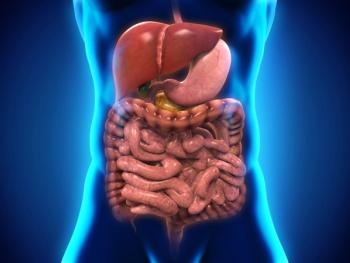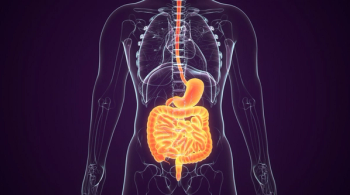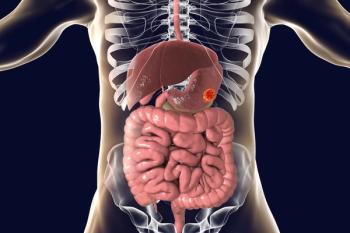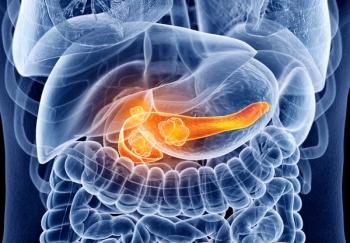
- ONCOLOGY Vol 10 No 9
- Volume 10
- Issue 9
New Developments in Chemotherapy for Patients With Advanced Pancreatic Cancer
Alleviation of tumor-related symptoms may be a more appropriate basis for judging drug efficacy in pancreatic cancer than is tumor shrinkage. Clinical benefit response (CBR), a new
ABSTRACT: Alleviation of tumor-related symptoms maybe a more appropriate basis for judging drug efficacy in pancreaticcancer than is tumor shrinkage. Clinical benefit response (CBR),a new way to assess clinical efficacy based on marked, sustainedimprovement in pain intensity, analgesic consumption, and performancestatus, was used to evaluate a new chemotherapeutic agent, gemcitabine(2',2'-difluorodeoxycytidine [Gemzar]). A phase III study of newlydiagnosed pancreatic cancer patients treated with either gemcitabineor fluorouracil (5-FU) and a phase II trial of gemcitabine inpatients whose disease had progressed despite prior treatmentwith 5-FU both demonstrated that a significant number of patientsachieved a CBR with gemcitabine. Prolonged survival was a secondarybenefit demonstrated in the phase III trial. In both studies,gemcitabine was well tolerated, with a relatively mild toxicityprofile. These results suggest that gemcita-bine may serve asa prototype for the development of more effective therapies forpancreatic cancer patients. [ONCOLOGY 10(Suppl):18-22, 1996]
Because pancreatic cancer has no early signs or symptoms, it tendsto be diagnosed at an advanced stage; 80% to 90% of patients presentwith disease that is not curable by surgery alone due to spreadof the cancer to adjacent tissues or beyond [1]. Metastatic pancreaticcancer has proven to be one of the most chemotherapy-resistanttumors, and, until recently, it has been difficult to demonstrateany beneficial impact of systemic therapy on this disease. Soberingtestimony to this is the fact that pancreatic cancer has the lowest5-year survival rate (3%) of any cancer listed in the Surveillance,Epidemiology, and End Results (SEER) data base of the NationalCancer Institute (NCI) [2]. A brief review of clinical trial resultsprior to 1995 will serve to place more recent results in properperspective.
Phase II Trials
A wide range of response rates can be found in single-agent phaseII trials in patients with advanced pancreatic cancer (as reviewedby Rothenberg et al) [3]. In evaluating these data, it is importantto keep in mind that clinical trial methodology and criteria forobjective response have evolved over time. Phase II trials conductedin the 1970s routinely included patients with different tumortypes in a single trial. As a result,response rates reported inthese studies were often based on a small number of patients withthat particular cancer and were therefore subject to a high degreeof statistical uncertainty. Trials performed prior to 1985 reliedheavily on estimation of tumor size by physical examination, withresponses defined as shrinkage of a palpable abdominal mass by50% or more or a reduction in palpable liver span by 30% or more[3].
The inherent inaccuracy of these techniques, intraobserver andinterobserver variability, and the influence of confounding factorson the size of the measured lesions all contributed to the initialreports of high response rates for drugs such as fluorouracil(5-FU), chlorambucil (Leukeran), and mitomycin (Mutamycin), aswell as the failure to confirm these promising response ratesin subsequent trials, especially when CT scans were used to determinetumor response. It is instructive to review how these factorshave led to a substantial decrease in response rates reportedfor 5-FU during the past 35 years.
The earliest reports on the activity of 5-FU in pancreatic cancershowed response rates as high as 56% [4]. Subsequent trials, involvinglarger numbers of patients and relying on CT imaging to determineresponse, reported response rates of 0% to 19%, even when biochemicalmodulation or infusional schedules of drug administration wereutilized [5-9]. In effect, no drug has met the criteria for significantantitumor activity (ie, an objective response rate of 20% or more)using radiographic definitions of response in the post-CT era.
Phase III Trials
Two kinds of comparative studies have been conducted in patientswith advanced pancreatic cancer: those that compared active treatmentto best supportive care (to determine whether chemotherapy madeany difference in the outcome of these patients) and those thatcompared multiagent regimens to single-agent chemotherapy (todetermine whether combinations of drugs with distinct mechanismsof action could improve outcome over that achieved with singleagents). Of the three trials that compared active treatment tobest supportive care, two demonstrated no significant difference[10,11], while one generated very provocative results suggestinga substantial survival advantage in favor of a five-drug regimen(Mallinson regimen) [12]. A confirmatory trial was never done,and subsequent trials of the regimen failed to replicate the impressiveresults of this trial [13].
In fact, phase III trials comparing this or other promising multiagentregimens (such as streptozotocin, mitomycin, and 5-FU [SMF] or5-FU, Adriamycin, and mitomycin [FAM]) to single-agent 5-FU failedto demonstrate any advantage of multiagent chemotherapy over 5-FUalone [13,14]. Despite a number of promising preclinical leadsand provocative phase II study results, virtually no progresshas been made in chemotherapy for metastatic pancreatic cancerduring the past 30 years.
Between 1991 and 1994, 25 investigational new drugs were evaluatedin phase II trials for the treatment of pancreatic cancer. Themedian response rate in these trials was 0% (range, 0% to 14%)and the median survival was 3 months [3]. One trial conductedduring this period focused on gemcitabine (2',2'-difluorodeoxycytidine[Gemzar]). Although the objective response rate to this drug wasonly 11% and median survival was 5.6 months, several importantobservations were made in this trial [15]. The 1-year survivalrate was surprisingly high (23%), as the responses observed weredurable (more than 4 to more than 20 months). The most strikingaspect of this study, however, was the impact of gemcitabine ontumor-related symptoms. Of the five patients who had an objectiveresponse to gemcitabine, four were able to resume normal dailyactivities. Three of the five patients were also able to reducetheir daily consumption of analgesics. An additional 14 patientswho did not meet radiographic criteria for response experienceddisease stabilization for 4 months or more, and, of these, 9 hadan improvement in performance status.
These results raised the question, how could a cytotoxic agentproduce any beneficial effect without substantial tumor shrinkage?Several possible explanations have been proposed. First, gemcitabinecould have been acting merely as an analgesic. This explanationwas not felt to be likely since analgesic requirements tend toincrease as the patient develops tolerance, the tumor grows, andthe pain becomes more severe. Patients in this trial experiencedsignificant alleviation of tumor-related symptoms on a stabledose of gemcitabine, and that effect was not lost during the 1week out of every 4 in which the patient did not receive chemotherapy.
Another possible explanation was that gemcitabine may have interferedwith neurotrophic growth factors that are essential for the spreadand invasion of the tumor into the celiac plexus, which lies directlybehind the pancreas. Evidence to support this theory is currentlylacking.
Alternatively, minimal tumor shrinkage (ie, less than the 50%shrinkage required to qualify as an objective response) may havebeen sufficient to relieve the compression or invasion of theceliac plexus by the tumor. In other words, the standard paradigmfor the determination of antitumor activity may not be well suitedfor pancreatic cancer.
Further examination suggests that tumor shrinkage may be an especiallyinappropriate way of determining the antitumor effect of cytotoxictherapy in pancreatic cancer. It is important to recognize ourcurrent limitations in the noninvasive imaging of pancreatic cancer.Standard CT scanning does not reliably distinguish a pancreatictumor from normal pancreatic tissue, tumor desmoplasia, or pancreatitis.Incomplete opacification of the small intestine makes it difficultto distinguish tumor from gut, as well. As a result, inclusionof noncancerous tissue may significantly overestimate tumor shrinkage(as in the case of inflammatory tissue being included in the tumormeasurement) or underestimate tumor shrinkage (if fibrotic tissuewas included in the tumor measurement).
For these reasons, consideration was given to the developmentof clinical end points that could capture the impact of new therapieson the disability caused by the disease. The NCI and the FDA havejointly acknowledged that relief of tumor-related symptoms isa worthwhile goal of cancer treatment, which can serve as thebasis for new drug approval [16]. Pancreatic cancer may representthe ideal setting for applying this approach to drug development,since there is a well-defined constellation of symptoms presentin the majority of patients with advanced pancreatic cancer: painin more than 72% of patients, weight loss in 92%, anorexia in64%, and nausea in 50% [17].
Recently, instruments that measure quality of life with acceptablereliability and validity have become available for cancer patients[18-21]. These instruments should prove useful in assessing theimpact of new therapies on this disease. With the well-definedtumor symptoms associated with advanced pancreatic cancer, specificassessment of tumor-related symptoms can provide information thatmay not be specifically covered by more general quality-of-lifequestionnaires.
Clinical Benefit Response
Andersen and colleagues have developed a method of assessing clinicalbenefit response (CBR) in pancreatic cancer patients that is basedon changes in pain (measuring pain intensity and daily analgesicconsumption), Karnofsky performance scale (KPS) status, and weight[22]. In this system, pain and KPS status are considered the primarymeasures of CBR, with weight serving as a secondary (and tie-breaking)assessment in the event that both primary measures are stable.
In order to be useful, the criteria for CBR had to be stringentand clearly defined so that minor changes in symptoms that couldbe due to natural fluctuations in the disease course would beexcluded. In order to accomplish this, changes in disease-relatedsymptoms had to be marked and sustained. Criteriafor CBR consist of a 50% or greater improvement (ie, reduction)in pain (as measured on a 100-mm visual analog scale) comparedto baseline, a 50% or greater reduction in daily analgesic consumptioncompared to baseline, an improvement in KPS status by 20 pointsor more from baseline, or, in the absence of a positive changein either of these parameters, a gain in dry weight of 7% or morefrom baseline.
In order for a patient to qualify as a clinical benefit responder,these changes had to last for at least 4 weeks and be unaccompaniedby deterioration in any other parameter (Figure 1). Any negativechange in pain, analgesic consumption, or performance status,no matter what the magnitude, rendered the patient a nonresponder,even if there were positive changes in another parameter.
These criteria were applied prospectively in two complementaryclinical trials (one a phase II and the other a phase III study)in patients with advanced, unresectable pancreatic cancer. Whatmakes these trials unique is that they were the first to utilizesymptom-centered criteria as the primary end point to determinethe efficacy of a new cytotoxic agent--in this case, gemcitabine.
For a clinical trial to be designed around alleviation of tumor-relatedsymptoms, eligibility criteria must require that the patientsbe symptomatic upon entry. For both the phase II and phase IIIstudies, patients were required, at baseline, to have an impairedfunctional status, defined as a KPS status of 50, 60, or 70; painintensity of at least 20 (on a scale of 0 to 100); and/or dailyanalgesic consumption of 10 morphine-equivalent milligrams. Patientswho met none of the three criteria were not eligible for thesetrials.
It is well known that KPS status and disability from tumor-relatedsymptoms are poor prognostic factors for survival from any cancer.Therefore, the requirement of impaired KPS and/or significanttumor-related disability served to select a subset of patientswho would be expected to have a shorter survival compared withasymptomatic patients with the same extent of disease. For thisreason, direct comparison of the survival data from these trialswith survival data from any other trials that did not have thesame selection criteria is not appropriate.
Phase III Trial Results
As has been previously reported, 160 patients with newly diagnosed,unresectable pancreatic cancer were enrolled in the phase IIItrial [23]. Since establishment of a reliable baseline was criticalfor proper analysis of the study results, patients had to havestable pain intensity and stable analgesic consumption prior tothe initiation of therapy. A total of 126 patients completed thispain stabilization period and were then randomized to treatmentwith gemcitabine or 5-FU. Gemcitabine (1,000 mg/m²) was administeredintravenously as a 30-minute infusion once weekly for 7 weeks,followed by 1 week of rest; thereafter, the drug was given onceweekly for 3 consecutive weeks out of every 4. Fluorouracil wasadministered intravenously at a weekly dose of 600 mg/m²as a 30-minute infusion.
Both treatment arms were well balanced in terms of gender, age,and disease stage, with more than 70% of patients having stageIV disease at diagnosis. The extent and severity of tumor-relatedsymptoms were also well matched between the treatment arms.
Fifteen patients (23.8%) treated with gemcitabine achieved a CBR,as compared with only three patients (4.8%) treated with 5-FU.This difference is highly statistically significant (P = .0022using the two-sided test for difference in binomial proportions).The median duration of CBR for gemcitabine-treated patients was18 weeks, as opposed to 13 weeks for 5-FU-treated patients.
Gemcitabine was also superior to 5-FU in terms of the trial'ssecondary end points. Median survival for gemcitabine-treatedpatients was 5.65 months vs 4.41 months for 5-FU-treated patients.In addition, the probability of survival at 1 year was 18% inthe gemcitabine group, as compared with 2% in the 5-FU group.The survival advantage for gemcitabine-treated patients was alsostatistically significant (P = .0024 by the log rank test). Forthose patients (in either arm of the trial) who achieved completebenefit response (CBR), the probability of survival at 1 yearwas 41%, compared to 4% for non-CBR achievers, indicating thatCBR and survival probability track in the same direction.
Few objective responses were observed in either treatment arm.There were 3 partial responders [5.4%] out of 56 patients withmeasurable disease who were treated with gemcitabine. In contrast,none of the 57 patients with measurable disease who received 5-FUwere partial responders (P = .077).
An important consideration in assessing the value of a palliativetherapy in cancer patients is that the therapy be well tolerated.It would be difficult to justify the use of an agent that simplysubstitutes drug-induced toxicities for disease-related symptoms.Toxicity data from the phase III trial revealed that, at the dosesand schedules employed, both drugs were well tolerated. Grade4 hematologic toxicities and grades 3 and 4 nonhematologic toxicitieswere rare in both arms. Of grades 3 and 4 toxicities, those thatoccurred in more than 10% of patients included grade 3 neutropeniaand elevations of alkaline phosphatase levels in gemcitabine-treatedpatients; no grade 4 toxicities were seen in more than 10% ofpatients [data on file, Eli Lilly and Company, Indianapolis, Indianaand ref 23].
Phase II Trial Results
The phase II study enrolled 63 patients with pancreatic cancerthat had progressed despite prior treatment with 5-FU [24]. Tobe eligible for the trial, patients had to have a significantdegree of tumor-related symptoms, as defined above. The dose andschedule for gemcitabine were identical to those used in the phaseIII trial.
In the phase II study, 17 patients (27.0%) experienced a CBR togemcitabine. Those patients who experienced a CBR did so quickly:The median time to onset of a CBR was 3 weeks. This is an attractivefeature for a treatment designed primarily for palliation. Themedian duration of CBR was 14 weeks, a clinically meaningful periodof time for this group of patients. Median survival of all patientstreated in this trial was 3.85 months. Objective responses wereseen in 6 (10.5%) of the 57 patients with measurable disease.
The toxicity profile for gemcitabine in this study was similarto that reported in the phase III study. Of grades 3 and 4 toxicities,those that occurred in more than 10% of patients included grade3 neutropenia and grade 3 elevations of alanine aminotransferase(ALT), aspartate aminotransferase (AST), and alkaline phosphataselevels; no grade 4 toxicities occurred with an incidence of morethan 10% [data on file, Eli Lilly and Company, Indianapolis, Indiana].Although not a comparative trial, this study was the first todemonstrate significant activity (as measured by CBR) for anytherapy as a second-line treatment in advanced pancreatic cancer.
Attempts to develop effective therapy for advanced, unresectablepancreatic cancer have met with little success over the past 30years. New cytotoxic drugs, novel biologic agents or biologic-responsemodifiers, new surgical and radiotherapeutic techniques, or acombination of these modalities have all failed to have any appreciableimpact on this disease. This has led to a sense of therapeuticnihilism for patients with metastatic pancreatic cancer [25].
A new therapeutic paradigm has been proposed for patients withdiseases such as advanced pancreatic cancer, in whom there isa high prevalence of debilitating symptoms and for whom no curativetherapy exists. This paradigm focuses on the alleviation of tumor-relatedsymptoms as a meaningful, worthwhile goal of treatment.
Gemcitabine is the first cytotoxic drug to be evaluated usingalleviation of tumor-related symptoms as the primary goal of treatment.The results of two complementary trials indicate that gemcitabineis useful in this setting, making it the first new therapy foradvanced pancreatic cancer in more than 30 years.* Gemcitabinehas an impact not only on the alleviation of tumor-related symptomsbut also on prolongation of survival. It has a relatively mildtoxicity profile that makes it appropriate for use in a cancerfor which no curative therapy exists.
These results suggest that gemcita-bine can serve as a model forthe development of more effective therapies for patients withpancreatic cancer in the future. Studies to evaluate gemcitabinein patients with earlier stages of pancreatic cancer, as wellas in combination with surgery, radiation, and other cytotoxicdrugs, have been initiated. These trials will help further defineand extend the utility of this important new drug in treatingone of the most virulent of all cancers.
*Editor's Note: Subsequent to the roundtable discussion,gemcitabine received FDA approval for the treatment of advancedand metastatic pancreatic cancer.
References:
1. Kelly DM, Benjamin IS: Pancreatic carcinoma. Ann Oncol 6:19-28,1995.
2. Ries LAG, Miller BA, Hankey BF, et al (eds): SEER Cancer StatisticsReview, 1973-1991: Tables and Graphs, pp 356-368. National CancerInstitute, NIH pub. no. 94-2789. Bethesda, MD, 1994.
3. Rothenberg ML, Abbruzzese JL, Moore M, et al: Commentary: Arationale for expanding the endpoints for clinical trials in advancedpancreas cancer (suppl). Cancer, 1996 (in press).
4. Hurley JD, Ellison EH: Chemotherapy of solid cancers arisingfrom the gastrointestinal tract. Ann Surg 152:568-582, 1960.
5. Hansen R, Quebbeman E, Ritch P, et al: Continuous 5-fluorouracil(5FU) infusion in carcinoma of the pancreas: A phase II study.Am J Med Sci 295:91-93, 1988.
6. Tajiri H, Yoshimori M, Okazaki N, et al: Phase II study ofcontinuous venous infusion of 5-fluorouracil in advanced pancreaticcancer. Oncology 48:18-21, 1991.
7. Crown J, Casper ES, Botet J, et al: Lack of efficacy of high-doseleucovorin and fluorouracil in patients with advanced pancreaticadenocarcinoma. J Clin Oncol 9:1682-1686, 1991.
8. DeCaprio JA, Mayer RJ, Gonin R, et al: Fluorouracil and high-doseleucovorin in previously untreated patients with advanced adenocarcinomaof the pancreas: Results of a phase II trial. J Clin Oncol 9:2128-2133,1991.
9. Pazdur R, Ajani JJ, Abbruzzese JL, et al: Phase II evaluationof fluorouracil and recombinant a-2a-interferon in previouslyuntreated patients with pancreatic adenocarcinoma. Cancer 70:2073-2076,1992.
10. Andersen JR, Friis-Mollek A, Hancke S, et al: A controlledtrial of combination chemotherapy with 5-FU and BCNU in pancreaticcancer. Scand J Gastroenterol 16:973, 1981.
11. Frey C, Twomey P, Keehn R, et al: Randomized study of 5-FUand CCNU in pancreatic cancer: Report of the Veterans AdministrationSurgical Adjuvant Cancer Chemotherapy Study Group. Cancer 47:27-31,1981.
12. Mallinson CN, Rake MO, Cocking JB, et al: Chemotherapy inpancreatic cancer: Results of a controlled, prospective, randomised,multicentre trial. Br Med J 281:1589-1591, 1980.
13. Cullinan S, Moertel CG, Wieand HS, et al: A phase III trialon the therapy of advanced pancreatic cancer: Evaluations of theMallinson regimen and combined 5-fluorouracil, doxorubicin, andcisplatin. Cancer 65:2207-2212, 1990.
14. Cullinan SA, Moertel CG, Fleming TR, et al for the North CentralCancer Treatment Group: A comparison of three chemotherapeuticregimens in the treatment of advanced pancreatic and gastric carcinoma:Fluorouracil vs fluorouracil and doxorubicin vs fluorouracil,doxorubicin, and mitomycin. JAMA 253:2061-2067, 1985.
15. Casper ES, Green MR, Kelsen DP, et al: Phase II trial of gemcitabine(2',2'-difluorodeoxycytidine) in patients with adenocarcinomaof the pancreas. Invest New Drugs 12:29-34, 1994.
16. O'Shaughnessy JA, Wittes RE, Burke G, et al: Commentary concerningdemonstration of safety and efficacy of investigational anticanceragents in clinical trials. J Clin Oncol 9:2225-2232, 1991.
17. Moossa AR, Dawson PJ, Franklin WA, et al: Tumors of the pancreas,in Moosa AR, Robson MC, Schimpff SC (eds): Comprehensive Textbookof Oncology, p 1105. Baltimore, Williams & Wilkins, 1986.
18. Schipper H, Clinch J, McMurray A, et al: Measuring the qualityof life of cancer patients: The Functional Living Index--Cancer:Development and validation. J Clin Oncol 2:472-483, 1984.
19. Cella DF, Tulsky DS, Gray G, et al: The Functional Assessmentof Cancer Therapy Scale: Development and validation of the generalmeasure. J Clin Oncol 11:570-579, 1993.
20. Ganz PA, Schag CAC, Lee JJ, et al: The CARES: A generic measureof health-related quality of life for patients with cancer. QualLife Res 1:19-29, 1992.
21. Aaronson NK, Ahmedzai S, Bergman B, et al: The European Organizationfor Research and Treatment of Cancer QLQ-C30: A quality-of-lifeinstrument for use in international clinical trials in oncology.J Natl Cancer Inst 85:365-376, 1993.
22. Andersen JS, Burris HA, Casper E, et al: Development of anew system for assessing clinical benefit for patients with advancedpancreatic cancer (abstract). Proc Am Soc Clin Oncol 13:A1600,1994.
23. Moore M, Andersen J, Burris H, et al: A randomized trial ofgemcitabine vs 5-FU as first-line therapy in advanced pancreaticcancer (abstract). Proc Am Soc Clin Oncol 14:A473, 1995.
24. Rothenberg ML, Moore MJ, Cripps MC, et al: A phase II trialof gemcitabine in patients with 5-FU-refractory pancreas cancer.Ann Oncol 7:347-353, 1996.
25. Taylor I: Should further studies of chemotherapy be carriedout in pancreatic cancer? Eur J Cancer 29A:1078-1081, 1993.
Articles in this issue
about 29 years ago
Antisense Gene Therapy Trials Underway in Patients With CMLover 29 years ago
BOOK REVIEW: Leukemiaover 29 years ago
Most Terminal AIDS Patients Want to Be Revived if Their Heart Stopsover 29 years ago
Disease Management: State of the Art in Pancreatic Cancerover 29 years ago
How to Better Communicate Cancer Risk to Patientsover 29 years ago
Gemcitabine Shows Promise as Combination Agent in NSCLCover 29 years ago
Data Review Shows Fruits and Vegetables Can Block Major CancersNewsletter
Stay up to date on recent advances in the multidisciplinary approach to cancer.
































































































